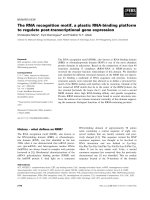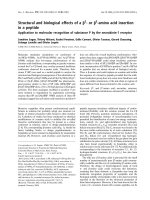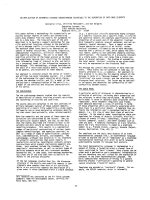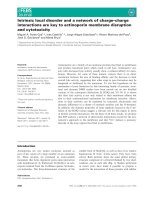Application of a human bone engineering platform to an in vitro and in vivo breast cancer metastasis model
Bạn đang xem bản rút gọn của tài liệu. Xem và tải ngay bản đầy đủ của tài liệu tại đây (9.67 MB, 280 trang )
Application of a Human Bone Engineering
Platform to an In Vitro and In Vivo Breast
Cancer Metastasis Model
Verena Maria Charlotte Reichert, MD
Faculty of Built Environment and Engineering, School of Engineering
Systems, Queensland University of Technology
Thesis submitted for:
Doctor of Philosophy (PhD)
2011
Keywords
Breast cancer, bone metastasis, human osteoblast matrix, breast cancer
related bone disease, adhesion, single cell force spectroscopy, migration,
invasion, tissue engineering, scaffold, polycaprolactone, osteoblasts, human
mesenchymal stem cells
I
II
Abstract
Breast cancer in its advanced stage has a high predilection to the skeleton.
Currently, treatment options of breast cancer-related bone metastasis are
restricted to only palliative therapeutic modalities. This is due to the fact that
mechanisms regarding the breast cancer celI-bone colonisation as well as
the interactions of breast cancer cells with the bone microenvironment are
not fully understood, yet. This might be explained through a lack of
appropriate in vitro and in vivo models that are currently addressing the
above mentioned issue.
Hence the hypothesis that the translation of a bone tissue engineering
platform could lead to improved and more physiological in vitro and in vivo
model systems in order to investigate breast cancer related bone
colonisation was embraced in this PhD thesis.
Therefore the first objective was to develop an in vitro model system that
mimics human mineralised bone matrix to the highest possible extent to
examine the specific biological question, how the human bone matrix
influences breast cancer cell behaviour. Thus, primary human osteoblasts
were isolated from human bone and cultured under osteogenic conditions.
Upon ammonium hydroxide treatment, a cell-free intact mineralised human
bone matrix was left behind. Analyses revealed a similar protein and mineral
composition of the decellularised osteoblast matrix to human bone. Seeding
of a panel of breast cancer cells onto the bone mimicking matrix as well as
reference substrates like standard tissue culture plastic and collagen coated
tissue culture plastic revealed substrate specific differences of cellular
behaviour. Analyses of attachment, alignment, migration, proliferation,
invasion, as well as downstream signalling pathways showed that these
cellular properties were influenced through the osteoblast matrix.
The second objective of this PhD project was the development of a human
ectopic
bone
polycaprolactone
model
in
NOD/SCID
tricalcium phosphate
mice
using
medical
grade
(mPCL-TCP) scaffold. Human
osteoblasts and mesenchymal stem cells were seeded onto an mPCL-TCP
III
scaffold, fabricated using a fused deposition modelling technique. After
subcutaneous implantation in conjunction with the bone morphogenetic
protein 7, limited bone formation was observed due to the mechanical
properties of the applied scaffold and restricted integration into the soft tissue
of flank of NOD/SCID mice. Thus, a different scaffold fabrication technique
was chosen using the same polymer. Electrospun tubular scaffolds were
seeded with human osteoblasts, as they showed previously the highest
amount of bone formation and implanted into the flanks of NOD/SCID mice.
Ectopic bone formation with sufficient vascularisation could be observed.
After implantation of breast cancer cells using a polyethylene glycol hydrogel
in close proximity to the newly formed bone, macroscopic communication
between the newly formed bone and the tumour could be observed.
Taken together, this PhD project showed that bone tissue engineering
platforms could be used to develop an in vitro and in vivo model system to
study cancer cell colonisation in the bone microenvironment.
IV
Table of contents
Keywords ..................................................................................................... I
Abstract ..................................................................................................... III
Table of contents ........................................................................................ V
List of illustrations and diagrams ............................................................. XIII
List of abbreviations ................................................................................ XIX
Statement of original authorship ............................................................ XXV
Acknowledgements.............................................................................. XXVII
Chapter 1 - Overview .................................................................................... 1
1. Overview .............................................................................................. 3
Chapter 2 - Literature Review - Mechanisms of breast cancer-related bone
metastasis – overview of currently used in vitro and in vivo models .............. 5
2.1
Epidemiology – facts about breast cancer ........................................ 7
2.2
Clinical presentation of bone metastases and treatment options ...... 8
2.3
Tumour cell metastasis – a multistep process – from the primary site
to the skeleton .......................................................................................... 11
2.4
Characteristics of the “the congenial soil” – bone ........................... 13
2.5
How the “seeds” find their “congenial” soil ...................................... 18
2.6
Attachment at the metastatic site - interaction of integrins with bone
matrix constituents .................................................................................... 19
2.7
More factors involved in the promotion of bone metastasis ............ 23
2.8
Osteomimicry of breast cancer cells ............................................... 26
2.9
Osteolytic bone metastasis ............................................................. 27
2.10
Models investigating bone-cancer cell interaction in vitro ............ 29
2.11
Models investigating bone-cancer cell interaction in vivo ............ 37
2.12
Summary ..................................................................................... 46
Chapter 3 - Establishment of a human primary osteoblast matrix model .... 49
3.1
Introduction ..................................................................................... 51
V
3.2
Material and Methods ...................................................................... 53
3.2.1
Characterisation of type I collagen coated tissue culture plastic ...
................................................................................................. 53
3.2.1.1
Collagen type I coating of tissue culture polystyrene or
thermanox coverslips.......................................................................... 53
3.2.1.2
Anti-col I staining of col I coated coverlips ......................... 53
3.2.1.3
Scanning electron microscopy analysis of col I coated
thermanox coverslips.......................................................................... 54
3.2.2
Generation and characterisation of primary human osteoblast
matrices ................................................................................................. 54
3.2.2.1
Isolation
of
human
primary
osteoblasts
and
matrix
production........................................................................................... 54
3.2.2.2
Confocal laser microscopy to confirm completeness of
decellularisation .................................................................................. 55
3.2.2.3
Morphology - SEM ............................................................. 56
3.2.2.4
Morphology - Transmission Electron microscopy ............... 56
3.2.2.5
Mineralisation - Alizarin red S ............................................ 56
3.2.2.6
Mineralisation - Wako HRII calcium assay ......................... 56
3.2.2.7
Mineralisation - X-ray photoelectron spectroscopy (XPS) .. 57
3.2.2.8
Mineralisation - RAMAN analysis ....................................... 57
3.2.2.9
Composition - Immunohistochemistry ................................ 58
3.2.2.10 Composition - Growth factor analysis................................. 59
3.2.2.11 Composition - 2D PAGE with MALDI or LC/MS/MS ........... 59
3.2.2.12 Composition - Western blot analysis .................................. 59
3.2.3
Image analysis .......................................................................... 60
3.2.4
Statistical analysis .................................................................... 61
3.3
Results ............................................................................................ 62
VI
3.3.1
Presence and Morphology of collagen I on coated thermanox
coverslips .............................................................................................. 62
3.3.2
Characterisation of the composition and morphology of the
human decellularised osteoblast matrix ................................................ 63
3.4
Discussion ...................................................................................... 75
3.5
Conclusion ...................................................................................... 79
Chapter 4 - Interactions of human breast cancer cells with the OBM.......... 81
4.1
Introduction ..................................................................................... 83
4.2
Materials and Methods.................................................................... 85
4.2.1
Characteristics and growth conditions for cell lines used in this
study
................................................................................................. 85
4.2.1.1
MCF10A ............................................................................ 85
4.2.1.2
T47D .................................................................................. 86
4.2.1.3
SUM1315 ........................................................................... 86
4.2.1.4
MDA-MB-231 ..................................................................... 86
4.2.1.5
MDA-MB-231SA ................................................................ 87
4.2.1.6
Gene expression profile ..................................................... 88
4.2.2
Morphology .............................................................................. 89
4.2.2.1
Flow cytometry................................................................... 89
4.2.2.2
Morphology - Transmitted light microscopy ....................... 90
4.2.2.3
Morphology – Fluorescent staining .................................... 90
4.2.2.4
Morphology - SEM ............................................................. 91
4.2.3
Cell proliferation ....................................................................... 92
4.2.4
Cell adhesion ........................................................................... 92
4.2.5
Cell migration ........................................................................... 95
4.2.6
Cell Invasion ............................................................................. 96
4.2.6.1
SEM image analysis .......................................................... 96
4.2.6.2
Confocal microscopy image analysis ................................. 98
VII
4.2.7
Cell signalling pathways ........................................................... 98
4.2.8
Gene expression .................................................................... 100
4.2.8.1
RNA isolation ................................................................... 100
4.2.8.2
cDNA synthesis ................................................................ 100
4.2.8.3
qRT-PCR ......................................................................... 101
4.2.9
4.3
Statistical analysis .................................................................. 102
Results .......................................................................................... 103
4.3.1
Characteristics of utilised cell lines ......................................... 103
4.3.1.1
MCF10A ........................................................................... 103
4.3.1.2
T47D ................................................................................ 104
4.3.1.3
SUM1315 ......................................................................... 105
4.3.1.4
MDA-MB-231 ................................................................... 106
4.3.1.5
MDA-MB-231-SA ............................................................. 107
4.3.2
Cell morphology of different cell lines on TCP, col I and OBM 113
4.3.2.1
Morphology on TCP, col I and OBM assessed with
transmitted light and confocal laser scanning microscopy ................ 113
4.3.2.2
4.3.3
Image analysis ................................................................. 116
Proliferation of MCF10A, T47D, SUM1315, MDA-MB231 and
MDA-MB-231SA on TCP, col I and OBM ............................................ 120
4.3.4
Assessment of established detachment forces of each cell line
to disconnect from col I and OBM ........................................................ 121
4.3.5
Migratory features of the 5 BC cell lines on the three
investigated substrates ........................................................................ 123
4.3.6
Invasive potential of MCF10A, T47D, SUM1315, MDA-MB-231
and MDA-MB-231SA cells ................................................................... 127
4.3.6.1
SEM image analysis......................................................... 127
4.3.6.2
Confocal microscopy image analysis ............................... 127
VIII
4.3.7
Western blot analysis of five cell lines on different substrates to
examine various cell signalling pathways ............................................ 131
4.3.7.1
FAK .................................................................................. 132
4.3.7.2
MAPK .............................................................................. 133
4.3.8
mRNA expression profile of MCF10A, T47D, SUM1315, MDA-
MB231 and MDA-MB-231SA cells on TCP, col I and OBM ................. 135
4.3.8.1
Attachment....................................................................... 135
4.3.8.2
Invasion ........................................................................... 138
4.4
Discussion .................................................................................... 140
4.5
Conclusion .................................................................................... 157
Chapter 5 - Human bone and marrow derived progenitor cells and their
potential for human bone tissue engineering using a medical grade
polycaprolactone-tricalcium phosphate scaffold in NOD/SCID mice .......... 161
5.1
Introduction ................................................................................... 163
5.2
Materials and Methods.................................................................. 166
5.2.1
Cells ....................................................................................... 166
5.2.1.1
Isolation of human osteoblasts ........................................ 166
5.2.1.2
Human mesenchymal precursor cells .............................. 166
5.2.2
Characteristics of human osteoblasts and human mesenchymal
precursor cells under osteogenic conditions on TCP (2D) .................. 167
5.2.2.1
Cell culture ....................................................................... 167
5.2.2.2
Mineralisation - Alizarin red S .......................................... 167
5.2.2.3
Mineralisation - Wako HRII calcium assay ....................... 167
5.2.3
In vitro characterisation of hOBs and hMSCs on a medical grade
polycaprolactone tricalcium phosphate (mPCL-TCP) scaffold............. 167
5.2.3.1
Scaffold fabrication using fused deposition modelling
technique ......................................................................................... 167
5.2.3.2
Cell seeding ..................................................................... 168
IX
5.2.3.3
Seeding efficiency and proliferation ................................. 168
5.2.3.4
Cell viability ...................................................................... 169
5.2.3.5
Cell morphology ............................................................... 169
5.2.3.6
RNA isolation, primer design and qRT-PCR .................... 170
5.2.4
Ectopic bone assay ................................................................ 172
5.2.4.1
Implantation ..................................................................... 172
5.2.4.2
Calcein injection and imaging of live animals ................... 173
5.2.4.3
Micro-CT analysis ............................................................ 173
5.2.4.4
Biomechanical testing ...................................................... 174
5.2.5
Histology and immunohistochemistry ..................................... 174
5.2.5.1
Paraffin Embedding.......................................................... 174
5.2.5.2
Histochemistry
and
immunohistochemistry
on
paraffin
embedded samples .......................................................................... 174
5.2.5.3
Tartrate resistant acid phosphatase (TRAP) staining of
paraffin embedded samples ............................................................. 176
5.2.5.4
Resin Embedding ............................................................. 176
5.2.5.5
Histomorphometry ............................................................ 177
5.2.6
5.3
Statistical analysis .................................................................. 177
Results .......................................................................................... 178
5.3.1
Characteristics of human osteoblasts and human mesenchymal
precursor cells under osteogenic conditions on TCP (2D) ................... 178
5.3.1.1
Mineralisation ................................................................... 178
5.3.1.2
Proliferation ...................................................................... 179
5.3.1.3
qRT-PCR ......................................................................... 180
5.3.2
Characterisation of human marrow and bone derived cells on
the scaffold .......................................................................................... 181
5.3.2.1
Morphology and viability ................................................... 181
5.3.2.2
Proliferation ...................................................................... 183
X
5.3.2.3
5.3.3
5.4
qRT-PCR ......................................................................... 185
Ectopic bone assay ................................................................ 186
5.3.3.1
Live imaging..................................................................... 186
5.3.3.2
Micro-CT analysis ............................................................ 186
5.3.3.3
Biomechanical testing ...................................................... 187
5.3.3.4
Histological analysis ........................................................ 188
Discussion .................................................................................... 192
Chapter 6 - Human bone derived progenitor cells and their potential for
human bone tissue engineering using an electrospun polycaprolactone
scaffold with calcium-phosphate coating in NOD/SCID mice ..................... 201
6.1
Introduction ................................................................................... 203
6.2
Material and Methods ................................................................... 203
6.2.1
Cells ....................................................................................... 203
6.2.1.1
6.2.2
Isolation of human osteoblasts ........................................ 203
In vitro characterisation of the electrospun PCL scaffold ........ 203
6.2.2.1
Scaffold fabrication .......................................................... 203
6.2.2.2
Scaffold characteristics and testing in biological applications
......................................................................................... 203
6.2.2.3
Calcium phosphate coating ............................................. 205
6.2.2.4
Cell seeding ..................................................................... 206
6.2.2.5
Cell viability ...................................................................... 206
6.2.2.6
Cell morphology ............................................................... 206
6.2.3
Ectopic bone assay ................................................................ 206
6.2.3.1
Implantation ..................................................................... 206
6.2.3.2
Implantation of PEG gels incorporated with human breast
cancer cells ...................................................................................... 207
6.2.3.3
Micro-CTanalysis ............................................................. 208
6.2.3.4
Histology .......................................................................... 208
XI
6.3
Results .......................................................................................... 209
6.3.1
In vitro characterisation of hOBs on the electrospun scaffold . 209
6.3.1.1
6.3.2
Morphology and viability ................................................... 209
Morphology assessment of BC cells in PEG gels cultured in vitro
............................................................................................... 209
6.3.3
Ectopic bone assay ................................................................ 210
6.3.3.1
Implantation ..................................................................... 210
6.3.3.2
Micro-CT-analysis ............................................................ 211
6.3.3.1
Histological analysis ......................................................... 211
6.4
Discussion ..................................................................................... 215
6.5
Conclusion – Chapter 5 and 6 ....................................................... 218
Chapter 7 - Future directions ..................................................................... 221
Chapter 8 – Bibliography ........................................................................... 227
XII
List of illustrations and diagrams
Chapter 2
Figure 1:
Schematic of bone structure and types of metastases
visualized by imaging modalities
9
Figure 2:
Main steps of tumour progression and metastasis
13
Figure 3:
Description of the basic multicellular unit
17
Figure 4:
Potential role of the plasminogen activators and
plasmin in the pericellular activation cascade for MMPs
26
Figure 5:
Vicious cycle of bone metastases
28
Figure 6:
Illustration of the compartmentalised bioreactor model
32
Figure 7:
Illustration of the acellular bone matrix model utilised
by Pathi et al.
36
Figure 8:
Image of intracardiac injection
41
Chapter 3
Figure 9:
Immunohistochemical
thermanox coverslips
analysis
Figure 10:
SEM image of collagen I coated thermanox coverslip
63
Figure 11:
Human primary osteoblast explant culture
64
Figure 12:
Light microscopy
decellularised OBM
and
64
Figure 13:
Confocal microscopy image of OBM before and after
decellularisation
65
Figure 14:
SEM image of OBM before and after decellularisation
66
Figure 15:
SEM image of cortical human bone
66
Figure 16:
TEM images of OBM
67
Figure 17:
TEM reference image of synthetically produced
mineralised rat tail collagen fibrils
67
Figure 18:
Alizarin red staining of OBM
68
Figure 19:
Bar graph presenting calcium content of the OBM
69
Figure 20:
XPS analysis of the OBM
70
Figure 21:
XPS analysis of human native bone
70
Figure 22:
RAMAN spectra of non-mineralised and mineralised
OBM in addition to human native bone
71
image
XIII
of
of
col
I
coated
cellularised
62
Figure 23:
Immunohistochemistry for human bone ECM
72
Figure 24:
Protein analysis of OBM
73
Figure 25:
Western blot analysis of OBM
73
Figure 26:
Bar graph presenting the presence of different growth
factors in the OBM
74
Figure 27:
Adhesion of cells on an AFM cantilever
94
Figure 28:
SCFC measurement
95
Figure 29:
Exemplary SEM images for the invasion study
97
Figure 30:
98
Figure 31:
Exemplary confocal microscopy image for invasion
study
Light microscopy image of MCF10A cells
103
Figure 32:
Flow cytometry profile of MCF10A cells
104
Figure 33:
Light microscopy image of T47D cells
104
Figure 34:
Flow cytometry profile of T47D cells
105
Figure 35:
Light microscopy image of SUM1315 cells
105
Figure 36:
Flow cytometry profile of SUM1315 cells
106
Figure 37:
Light microscopy image of MDA-MB-231 cells
106
Figure 38:
Flow cytometry profile of MDA-MB-231 cells
107
Figure 39:
Light microscopy image of MDA-MB-231SA cells
107
Figure 40:
Flow cytometry profile of MDA-MB-231SA cells
108
Figure 41:
E-cadherin expression
109
Figure 42:
Vimentin expression
110
Figure 43:
Expression of IL-6 and IL-8
111
Figure 44:
Expression of Ck8 and Ck18
112
Figure 45:
Light microscopy images of MCF10A, T47D,
SUM1315, MDA-MB-231 and MDA-MB-231SA cells
cultured on TCP, col I and OBM
114
Figure 46:
Confocal laser microscopy images of MCF10A,
T47D,SUM1315, MDA-MB-231 and MDA-MB-231SA
cells cultured on TCP, col I and OBM
115
Figure 47:
Box plots demonstrating the shape factor of MCF10A,
T47D, SUM1315, MDA-MB-231 and MDA-MB-231SA
cells cultured on TCP, col I and OBM
117
Figure 48:
Box plots demonstrating the spreading area of
MCF10A, T47D, SUM1315, MDA-MB-231 and MDA-
118
Chapter 4
XIV
MB-231SA cells cultured on TCP, col I and OBM
Figure 49:
Polar blots demonstrating the orientation angel of
MCF10A, T47D, SUM1315, MDA-MB-231 and MDAMB-231SA cells cultured on TCP, col I and OBM
119
Figure 50:
Proliferation rate of MCF10A, T47D, SUM1315, MDAMB-231 and MDA-MB-231SA cells cultured on TCP,
col I and OBM
Box plots of detachment forces of MCF10A, T47D,
SUM1315, MDA-MB-231 and MDA-MB-231SA from
col I and OBM
120
Figure 52:
Bar graphs demonstrating mean squared displacement
of MCF10A, T47D, SUM1315, MDA-MB-231 and MDAMB-231SA on TCP, col I and OBM
125
Figure 53:
Bar graphs representing random migratory coefficient
and persistence time of MCF10A, T47D, SUM1315,
MDA-MB-231 and MDA-MB-231SA on TCP, col I and
OBM
126
Figure 54:
SEM images to determine the invasive potential of
MCF10A, T47D, SUM1315, MDA-MB-231 and MDAMB-231SA on OBM
128
Figure 55:
Bar graphs demonstrating the percentage of invaded
cells
129
Figure 56:
Cross sections of confocal images of MCF10A, T47D,
SUM1315, MDA-MB-231 and MDA-MB-231SA cells on
OBM at d 3
130
Figure 57:
Quantification of cross sections from confocal
microscopy images to determine invasiveness
131
Figure 58:
Image of a representative western blot analysing FAK
phosphorylation
132
Figure 59:
Quantification of western blot analysis regarding FAK
phosphorylation
133
Figure 60:
Image of a representative western blot analysing
p42/44 MAPK phosphorylation
134
Figure 61:
Quantification of western blot analysis regarding p42
MAPK phosphorylation
135
Figure 62:
Bar graphs demonstrating relative mRNA expression
levels of integrin alpha 2, 3, 5, v and beta 1and 3
137
Figure 63:
Bar graphs demonstrating relative mRNA expression
levels of MMP2 and MMP9
138
Figure 64:
Bar graphs demonstrating relative mRNA expression
level of OP
139
Figure 51:
XV
122
Chapter 5
Figure 65:
Schematic of scaffold implantation procedure
173
Figure 66:
Alizarin red staining of hMSC and hOBs
178
Figure 67:
Bar graph demonstrating the calcium content of hMSC
and hOBs
179
Figure 68:
Proliferation of hMSCs and hOBs in 2D
180
Figure 69:
Bar graphs representing quantitative RT-PCR analysis
of 2D cultures
182
Figure 70:
Images of morphology and viability of hMSCs and
hOBs in 3D
183
Figure 71:
SEM images of hMSCs and hOBs in 3D
184
Figure 72:
Graph indicating the proliferation of hMSCs and hOBs
in 3D
184
Figure 73:
Bar graphs displaying results from comparative qRTPCR analysis of 2D and 3D cultures
185
Figure 74:
Images displaying live imaging of mice after calcein
injections as well as scaffolds before and after
implantation
186
Figure 75:
Bar graphs demonstrating micro-CT analysis as well as
results from biomechanical testing
188
Figure 76:
Quantification
mineralisation
determined
189
Figure 77:
Representative images from micro-CT analysis, von
Kossa/van Gieson and H&E stained sections
190
Figure 78:
Images of TRAP, OC, and vWF stained sections
191
Figure 79:
Image of electrospun PCL tubes
203
Figure 80:
SEM image of electrospun sheets
204
Figure 81:
Image of viability assay displaying hMSCs on e-spun
meshes
205
Figure 82:
Schematic of scaffold implantation procedure
207
Figure 83:
Images displaying the morphology and viability of
hOBs on e-spun PCL-CaP scaffolds
209
Figure 84:
Confocal images of four cell lines incorporated in PEG
gels
210
of
histologically
Chapter 6
XVI
Figure 85:
Images of PCL-CaP scaffold and PEG gels before and
after implantation
211
Figure 86:
Micro-CT images as well as images of H&E and TRAP
stained histology sections
213
Figure 87:
Image displaying bone marrow-like features within the
human tissue engineered bone construct
214
List of Tables
Chapter 2
Table 1:
Major components of human bone and their overall
function
15
Table 2:
Main integrins and their ECM ligands that participate in
bone metastasis and tumour growth in bone
20
Table 3:
In vitro models investigating the mutual influence of
breast cancer cells with the bone microenvironment
31
Table 4:
Examples for in vivo models investigating cancer
metastasis to bone
38
Sequences of oligonucleotides used for qRT-PCR in
Chapter 4
102
Sequences of oligonucleotides used for qRT-PCR in
Chapter 5
172
Chapter 4
Table 5:
Chapter 5
Table 6:
XVII
XVIII
List of abbreviations
2D
Two dimensional
3D
Three dimensional
AFM
Atomic force microscopy
AIWH
Australian Institute of Health and Welfare
ALP
Alkaline phosphatase
AM
Adrenomedullin
ANOVA
Analysis of Variance
BC
Breast Cancer
BMP
Bone morphogenetic protein
BMSC
Bone marrow derived mesenchymal stem
cells
BMU
Basic multicellular unit
BSA
Bovine serum albumin
BSP
Bone sialoprotein
BV
Bone volume
BrdU
Bromdesoxyuridin
CaP
Calcium phosphate
Cbfa 1
core binding factor
CCN
Cyr61, CTGF, nov
CDM
Cellular derived matrix
Col I
Collage type I
CO2
Carbon dioxide
CSF
Colony stimulation factor
CT
Computed Tomography
CTGF
Connective tissue growth factor
CXC
Chemokine
CXCL
Chemokine ligand
CXCR
Chemokine receptor
Cyr 61
Cystein-rich protein 61
DAB
3,3-diaminobenzidine
dd
double distilled
DAPI
4’,6-diamidino-2-phenylindole
XIX
1 a.k.a. Runx-2
DIC
Differential interference contrast
DMEM
Dulbecco’s modified eagle medium
DNA
Deoxyribonucleic acid
DTC
Disseminated tumour cell
DTT
Dithiotreitol
ECL
Enhanced chemiluminescence
ECM
Extracellular matrix
EDTA
Ethylene-di-amine-tetra-acetic acid
EDS
Energy dispersive spectroscopy
EGFR
Epidermal growth factor receptor
ELISA
Enzyme linked immunosorbent assay
EMT
Epithelial to mesenchymal transition
ER
Oestrogen receptor
ERK
Extracellular signal-regulated kinase
FAK
Focal adhesion kinase
FBS
Foetal bovine serum
FDA
Fluorescein diacetate
FDA
Food and drug administration
FDM
Fused deposition modelling
FDG
Fluorodeoxyglucose
FGF
Fibroblast growth factor
FN
Fibronectin
Gla
-carboxylated
GRB2
Growth-factor-receptor-bound-2
HA
Hydroxyapatite
HCl
Hydrogen chloride
HE
Haematoxylin-eosin
HGF
Hepatocyte growth factor
Hh
Hedghog
H2O
Water
HRP
Horseradish peroxidase
HSC
Hematopoietic stem cell
hTEBC
Human tissue engineered bone construct
ICAM
Inter-cellular adhesion molecule
XX
IGF
Insulin-like growth factor
IgG
Immunoglobulin
IL
Interleukin
IP3
Phosphatidylinositol γ’-kinase
MALDI
Matrix-assisted laser desorption/ionisation
MAPK
Mitogen activated kinase
M-CSF
Macrophage colony stimulating factor
Micro-CT
Micro-computed tomography
MMA
Methyl-methacrylate
MMP
Matrix metalloproteinase
MMTV
Mouse mammary tumour virus
mPCL-TCP
Medical grade polycaprolactone tricalcium
phosphate
MRI
Magnetic resonance imaging
MSC
Mesenchymal stem cell
MSD
Mean squared displacement
NaOH
Sodium-hydroxide
NOD/SCID
non-obese diabetic/severe combined
immunodeficient
Nov
Nephroblastoma overexpressed
NPT
Sodium dependent phosphate transporter
OB
Osteoblast
OBM
Osteoblast matrix
OC
Osteoclast
OCPC
O-cresolphthalein complexion
OD
Optical density
ON
Osteonectin a.k.a SPARC
OP
Osteopontin
OPG
Osteoprotegerin
OPN
Osteopontin
Pa
Pascal
PAA
Polyacrylamide
PAGE
Polyacrylamide gel electrophoresis
PBS
Phosphate buffered saline
XXI
PCL
Polycaprolactone
PD
Photodiode
PDGF
Platelet derived growth factor
PEG
Polyethylene glycol
PET
Positron emission tomography
PFA
Paraformaldehyde
PI
Propidium iodide
PI3K
Phosphatidylinositol γ’-kinase
PLGA
poly(lactide-co-glycolide) acid
PMMA
Poly-Methyl methacrylate
Prkdc
DNA-dependent protein kinase catalytic
subunit
PTH
Parathyroid hormone
PTHrP
Parathyroid hormone related protein
PUR
Polyurethane
RANKL
Receptor activator nuclear factor kappa B
ligand
Rh
Recombinant human
RNA
Ribonucleic acid
ROCK
Rho associated kinase
RT
reverse transkriptase
RT-PCR
Real time polymerase chain reaction
Runx-2
Runt related transcription factor 2 a.k.a
Cbfa1
SBF
Simulated body fluid
SCFS
Single cell force spectroscopy
SD
Standard deviation
SDF-1
Stromal cell derived factor a.k.a. CXCL12
SDS
Sodium dodecyl sulfate
SEM
Scanning electron microscopy
SEM
Standard error of the mean
SFK
Src-family kinase
SOS
Son-of-sevenless
XXII
SPARC
Secreted protein, acidic cysteine-rich, a.k.a
osteonectin
SPECT
Single
photon
emission
computed
tomography
SS
Skeletal scintigraphy
TBST
Tris buffered saline and Tween 20
TCP
Tri-calcium phosphate
TCP
Tissue culture plastic
TE
Tissue engineering
TEBC
Tissue engineered bone construct
TEM
Transmission electron microscopy
TGF
Transforming growth factor
TIMP
Tissue inhibitor of metalloproteinase
TNF-
Tumour necrosis factor
TOF
time-of-flight
TRAP
Tartrate resistant acid phosphatase
TSP-1
Thrombospondin 1
VCAM
Vascular cell adhesion molecule 1
VEGF
Vascular endothelial growth factor
VN
Vitronectin
Wnt
Wingless
XPS
X-ray photoelectron spectroscopy
XXIII









